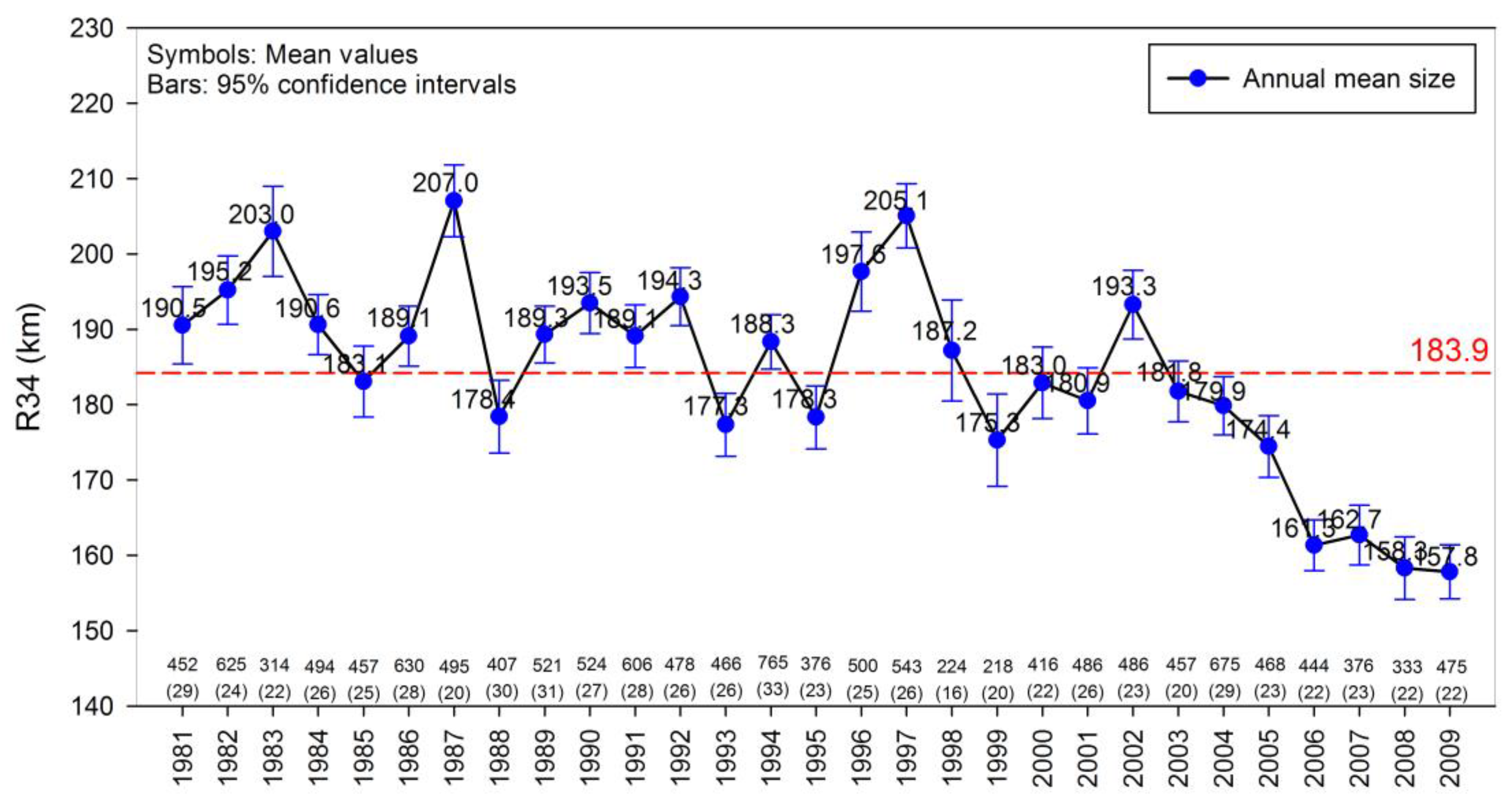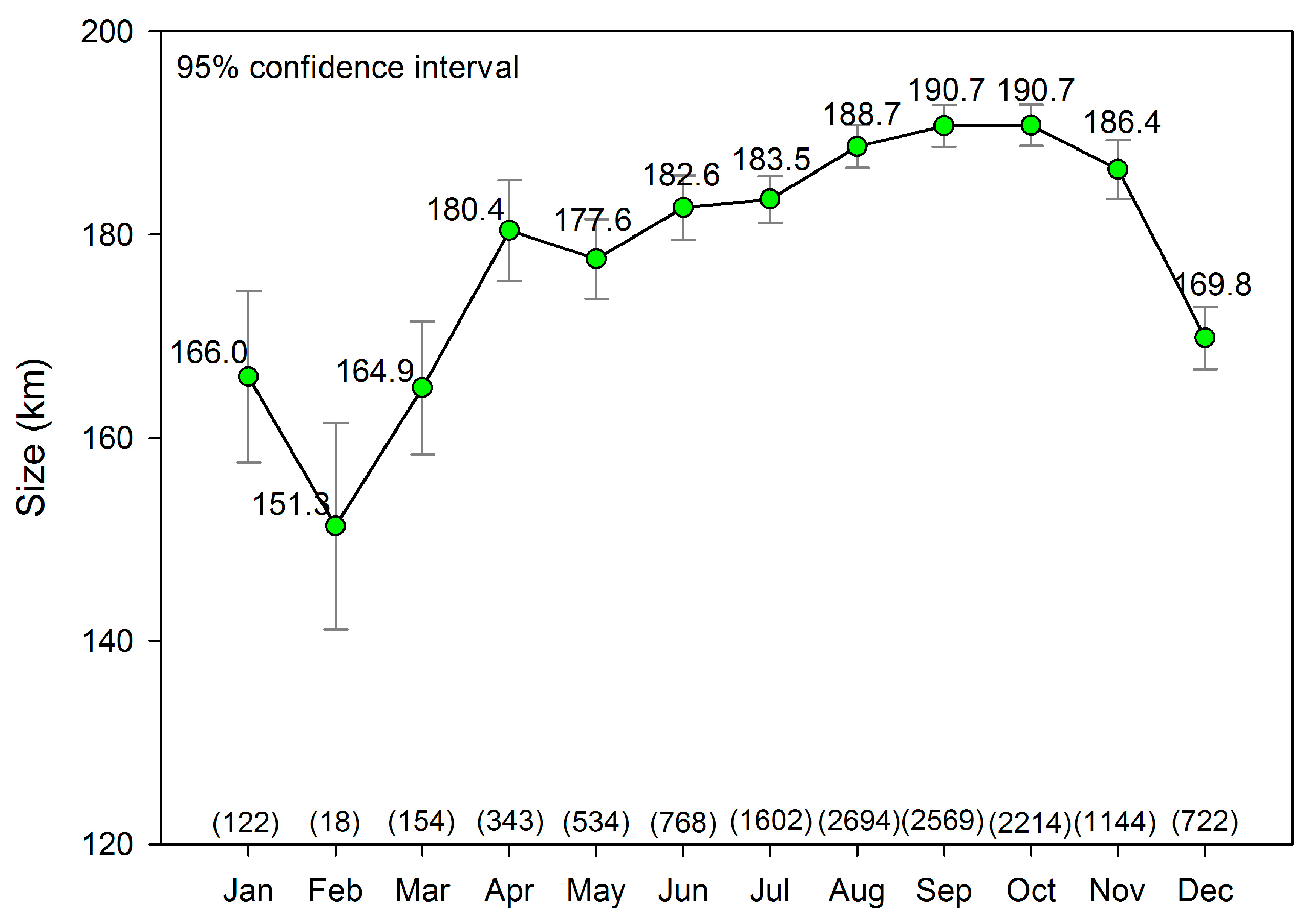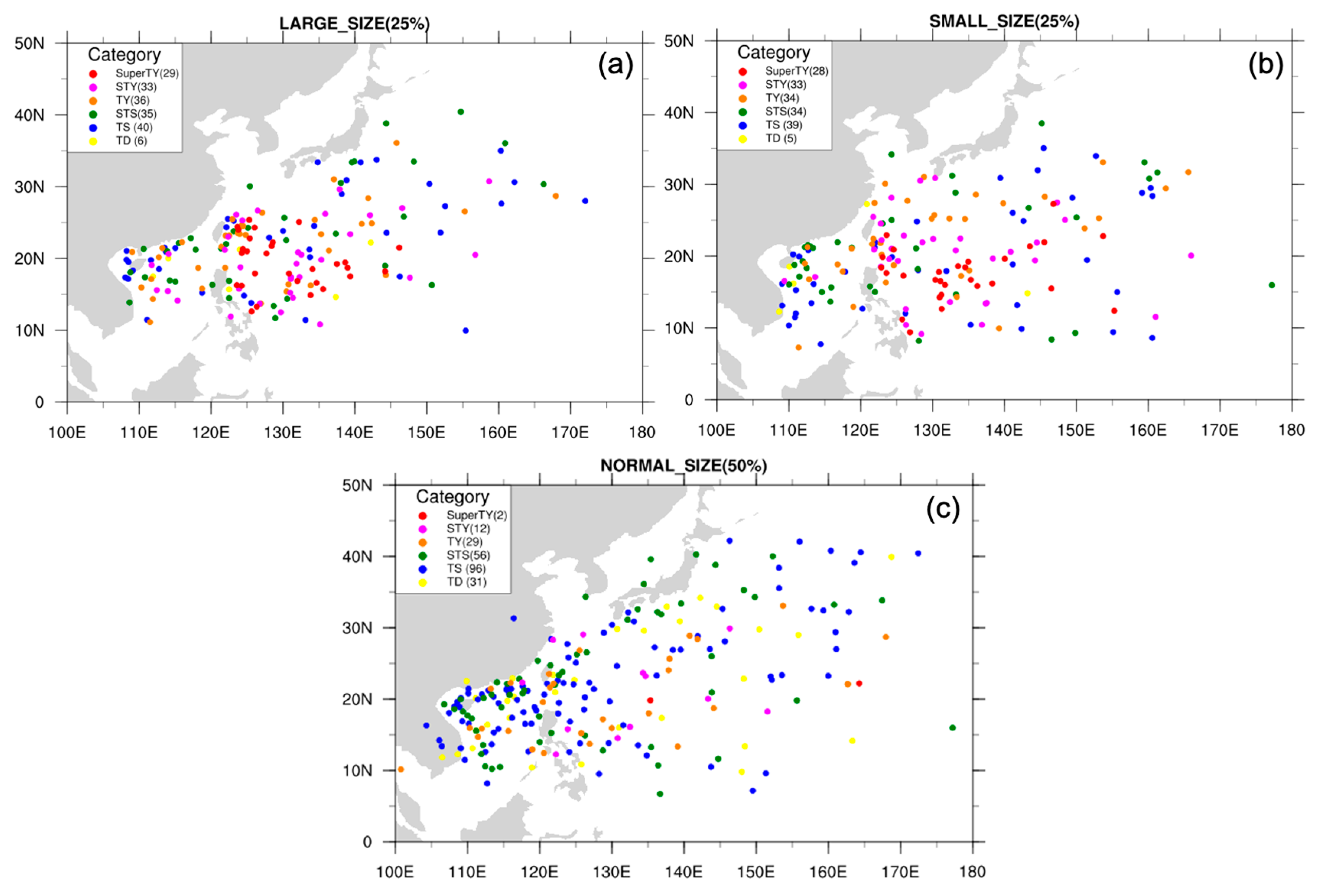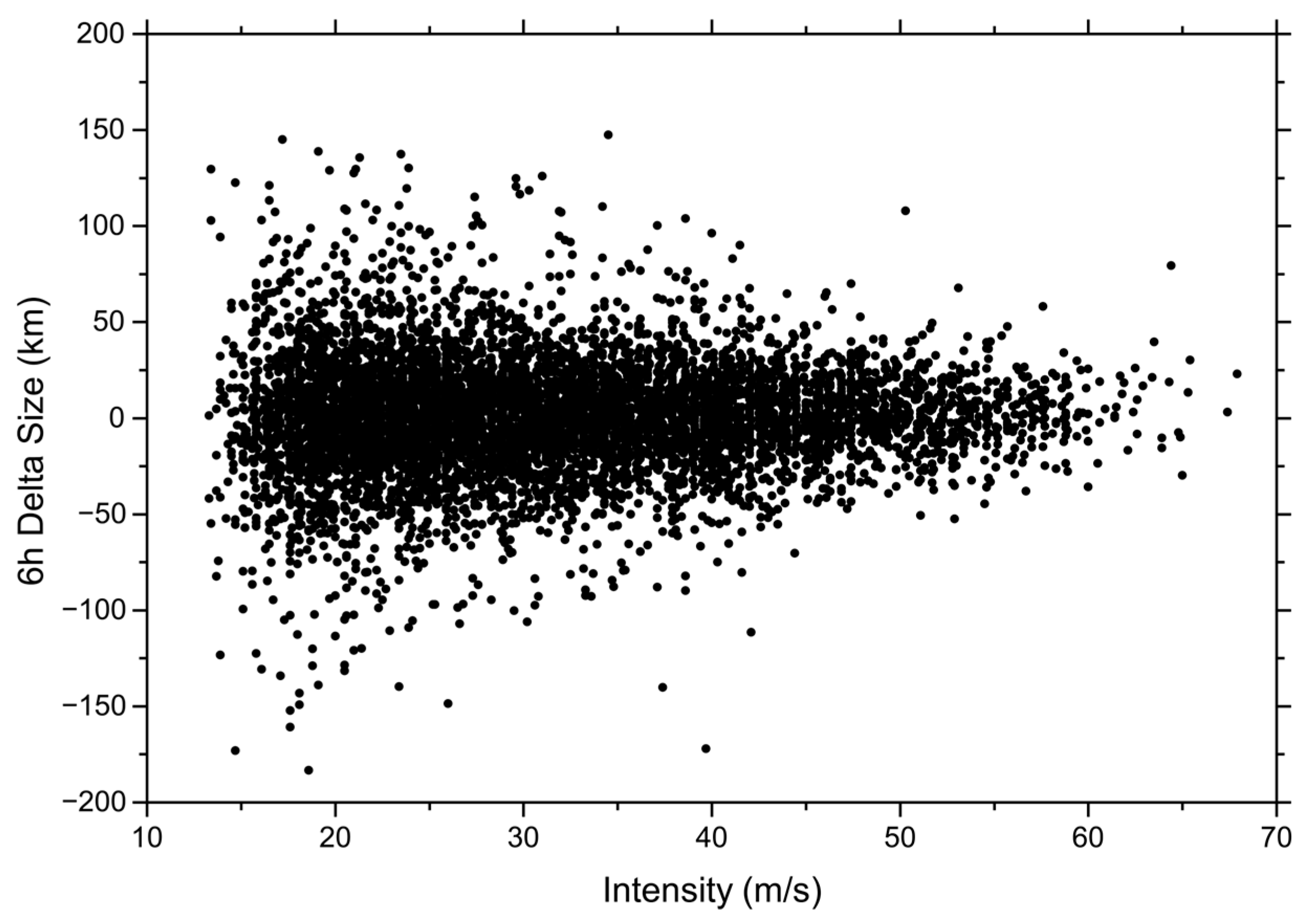Investigating the Characteristics of Tropical Cyclone Size in the Western North Pacific from 1981 to 2009
Abstract
:1. Introduction
2. Data
3. Results
3.1. Interannual Variation
3.2. Monthly Variation
3.3. Relationship between TC Intensity and Size
4. Summary
Author Contributions
Funding
Institutional Review Board Statement
Informed Consent Statement
Data Availability Statement
Acknowledgments
Conflicts of Interest
References
- Pielke, R.A., Jr.; Gratz, J.; Landsea, C.W.; Collins, D.; Saunders, M.A.; Musulin, R. Normalized hurricane damage in the United States: 1900–2005. Nat. Hazards Rev. 2008, 9, 29–42. [Google Scholar] [CrossRef]
- Peduzzi, P.; Chatenoux, B.; Dao, H.; Bono, A.; Herold, C.; Kossin, J.; Mouton, F.; Nordbeck, O. Global trends in tropical cyclone risk. Nat. Clim. Chang. 2012, 2, 289–294. [Google Scholar] [CrossRef]
- Chen, L.S.; Meng, Z. Research Progress of Tropical cyclones in China in the past decade. Sci. Atmos. 2001, 25, 588–600. (In Chinese) [Google Scholar]
- Chen, Y.; Zhou, J.; Ma, F. Overview of Typhoon landfall research in China. Sci. Meteorol. Sin. 2005, 25, 319–329. (In Chinese) [Google Scholar]
- Wen, K. China Climate Festival (Hainan Volume, Guangxi Volume, Guangdong Volume, Fujian Volume, Zhejiang Volume, Jiangsu Volume, Shanghai Volume, Shandong Volume, Hebei Volume, Beijing Volume, Tianjin Volume, Liaoning Volume); China Meteorological Press: Beijing, China, 2006. (In Chinese)
- Zhang, W.; Lu, X.; Shao, D.; Ying, M. Tropical Cyclone Yearbook (2001); China Meteorological Press: Beijing, China, 2002. (In Chinese)
- Wang, Y.; Wu, C.C. Current understanding of tropical cyclone structure and intensity changes-a review. Meteorol. Atmos. Phys. 2004, 87, 257–278. [Google Scholar] [CrossRef]
- Chen, G.; Huang, R. Study on some climatic Issues of Tropical cyclone and typhoon activity in Northwest Pacific. Adv. Earth Sci. 2006, 21, 610–616. (In Chinese) [Google Scholar]
- Chen, L.; Xu, X.; Luo, Z.; Wang, J. Introduction to Tropical Cyclone Dynamics; China Meteorological Press: Beijing, China, 2002; pp. 5–6. (In Chinese)
- Ren, S.; Liu, Y.; Wu, G. Numerical Experimental study on the interaction between Subtropical High and Typhoon in the Northwest Pacific. J. Meteorol. 2007, 65, 329–340. (In Chinese) [Google Scholar]
- Yu, H.; Chen, G.; Zhou, C.; Wong, W.K.; Yang, M.; Xu, Y.; Chen, P.; Wan, R.; Hu, X. Are We Reaching the Limit of Tropical Cyclone Track Predictability in the Western North Pacific? Bull. Am. Meteorol. Soc. 2022, 103, E410–E428. [Google Scholar] [CrossRef]
- Landsea, C.W.; Cangialosi, J.P. Have we reached the limits of predictability for tropical cyclone track forecasting? Bull. Am. Meteorol. Soc. 2018, 99, 2237–2243. [Google Scholar] [CrossRef]
- Hill, K.A.; Lackmann, G.M. Influence of environmental humidity on tropical cyclone size. Mon. Weather Rev. 2009, 137, 3294–3315. [Google Scholar] [CrossRef]
- Chavas, D.R.; Emanuel, K.A. A QuikSCAT climatology of tropical cyclone size. Geophys. Res. Lett. 2010, 37, L18816. [Google Scholar] [CrossRef]
- Chan, K.T.F.; Chan, J.C.L. Size and strength of tropical cyclones as inferred from QuikSCAT data. Mon. Weather Rev. 2012, 140, 811–824. [Google Scholar] [CrossRef]
- Merrill, R.T. A comparison of large and small tropical cyclones. Mon. Weather Rev. 1984, 112, 1408–1418. [Google Scholar] [CrossRef]
- Wang, S.; Toumi, R. On the relationship between hurricane cost and the integrated wind profile. Environ. Res. Lett. 2016, 11, 114005. [Google Scholar] [CrossRef]
- Liu, K.S.; Chan, J.C.L. Size of tropical cyclones as inferred from ERS-1 and ERS- 2 data. Mon. Weather Rev. 1999, 127, 2992–3001. [Google Scholar] [CrossRef]
- Chavas, D.R.; Lin, N.; Dong, W.; Lin, Y. Observed Tropical Cyclone Size Revisited. J. Clim. 2016, 29, 2923–2939. [Google Scholar] [CrossRef]
- Knaff, J.A.; Longmore, S.P.; Molenar, D.A. An objective satellite-based tropical cyclone size climatology. J. Clim. 2014, 27, 455–476. [Google Scholar] [CrossRef]
- Brand, S. Very large and very small typhoons of the western North Pacific Ocean. J. Meteorol. Soc. Jpn. 1972, 50, 332–341. [Google Scholar] [CrossRef]
- Pennington, J.; DeMaria, M.; Williams, K. Development of a 10-Year Atlantic Basin Tropical Cyclone Wind Structure Climatology. Available online: http://www.bbsr.edu/rpi/research/demaria/demaria4.html (accessed on 17 July 2019).
- Yuan, J.; Wang, D.; Wan, Q.; Liu, C. A 28-year climatological analysis of size parameters for Northwestern Pacific tropical cyclones. Adv. Atmos. Sci. 2007, 24, 24–34. [Google Scholar] [CrossRef]
- Kimball, S.K.; Mulekar, M.S. A 15-year climatology of North Atlantic tropical cyclones. Part I: Size parameters. J. Clim. 2004, 17, 3555–3575. [Google Scholar] [CrossRef]
- Chen, K.X.; Chen, G.H.; Xiang, C.Y.; Li, X.L. Climatic statistical characteristics of tropical cyclone field structure in the Northwest Pacific Ocean based on MTCSWA wind field data. Clim. Environ. Res. 2020, 25, 588–600. (In Chinese) [Google Scholar]
- Chan, J.C.L.; Yip, C.K.M. Interannual variations of tropical cyclone size over the western North Pacific. Geophys. Res. Lett. 2003, 30, 2267. [Google Scholar] [CrossRef]
- Quiring, S.; Schumacher, A.; Labosier, C.; Zhu, L. Variations in mean annual tropical cyclone size in the Atlantic. J. Geophys. Res. 2011, 116, D09114. [Google Scholar] [CrossRef]
- Demuth, J.; DeMaria, M.; Knaff, J.A. Improvement of advanced microwave sounder unit tropical cyclone intensity and size estimation algorithms. J. Appl. Meteorol. Climatol. 2006, 45, 1573–1581. [Google Scholar] [CrossRef]
- Lu, X.; Yu, H.; Yang, X.; Li, X. Estimating Tropical Cyclone Size in the Northwestern Pacific from Geostationary Satellite Infrared Images. Remote Sens. 2017, 9, 728. [Google Scholar] [CrossRef]
- Ying, M.; Zhang, W.; Yu, H.; Lu, X.; Feng, J.; Fan, Y.; Zhu, Y.; Chen, D. An overview of the China Meteorological Administration tropical cyclone database. J. Atmos. Ocean. Technol. 2014, 31, 287–301. [Google Scholar] [CrossRef]
- Lu, X.; Yu, H.; Ying, M.; Zhao, B.; Zhang, S.; Lin, L.; Bai, L.; Wan, R. Western North Pacific tropical cyclone database created by the China Meteorological Administration. Adv. Atmos. Sci. 2021, 38, 690–699. [Google Scholar] [CrossRef]
- GB/T 19201-2006; Grade of Tropical Cyclones. China Standards Press: Beijing, China, 2006. (In Chinese)
- Wu, L.; Tian, W.; Liu, Q.; Cao, J.; Knaff, J.A. Implications of the observed relationship between tropical cyclone size and intensity over the western North Pacific. J. Clim. 2015, 28, 9501–9506. [Google Scholar] [CrossRef]
- Wang, S.; Toumi, R. A historical analysis of the mature stage of tropical cyclones. Int. J. Climatol. 2018, 38, 2490–2505. [Google Scholar] [CrossRef]






| Classification | No. of TCs | Average Lag or Lead Time |
|---|---|---|
| maximum size reaches after peak intensity | 421 | Lag: 8.3 h |
| maximum size reaches before peak intensity | 182 | Lead: 9.2 h |
| maximum size coincides with peak intensity | 99 | 0 h |
Disclaimer/Publisher’s Note: The statements, opinions and data contained in all publications are solely those of the individual author(s) and contributor(s) and not of MDPI and/or the editor(s). MDPI and/or the editor(s) disclaim responsibility for any injury to people or property resulting from any ideas, methods, instructions or products referred to in the content. |
© 2023 by the authors. Licensee MDPI, Basel, Switzerland. This article is an open access article distributed under the terms and conditions of the Creative Commons Attribution (CC BY) license (https://creativecommons.org/licenses/by/4.0/).
Share and Cite
Cao, Q.; Lu, X.; Chen, G. Investigating the Characteristics of Tropical Cyclone Size in the Western North Pacific from 1981 to 2009. Atmosphere 2023, 14, 1468. https://doi.org/10.3390/atmos14091468
Cao Q, Lu X, Chen G. Investigating the Characteristics of Tropical Cyclone Size in the Western North Pacific from 1981 to 2009. Atmosphere. 2023; 14(9):1468. https://doi.org/10.3390/atmos14091468
Chicago/Turabian StyleCao, Qing, Xiaoqin Lu, and Guomin Chen. 2023. "Investigating the Characteristics of Tropical Cyclone Size in the Western North Pacific from 1981 to 2009" Atmosphere 14, no. 9: 1468. https://doi.org/10.3390/atmos14091468
APA StyleCao, Q., Lu, X., & Chen, G. (2023). Investigating the Characteristics of Tropical Cyclone Size in the Western North Pacific from 1981 to 2009. Atmosphere, 14(9), 1468. https://doi.org/10.3390/atmos14091468






